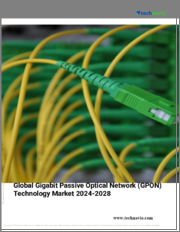
|
시장보고서
상품코드
1451555
세계의 GPON 장비 시장 보고서 : 장비 유형별, 최종 사용자별, 지역별(2024-2032년)GPON Equipment Market Report by Equipment Type (Optical Line Terminal (OLT), Optical Network Terminal (ONT)), End User (Hospitals, Residential, IT and Telecom, and Others), and Region 2024-2032 |
||||||
세계 GPON 장비 시장 규모는 2023년 200억 달러에 달했습니다. IMARC 그룹은 2032년 시장 규모가 645억 달러에 달하고 2024-2032년간 연평균 성장률(CAGR)이 13.6%를 나타낼 것으로 예측했습니다.
기가비트 패시브 광 네트워크(GPON) 장비는 광 분배 네트워크(ODN) 연결에 사용되는 포인트 투 멀티 포인트 액세스 네트워크입니다. 스플리터, OLT(Optical Line Terminal), ONU(Optical Network Unit)로 구성되며, OLT는 중앙 사무실에서 플라스틱과 유리로 만든 광섬유 케이블에 광자를 주입하고 스플리터는 중앙 사무실에서 단일 신호를 여러 신호로 분할합니다. 은 유지 보수 필요성을 줄이고 네트워크 관리를 용이하게하며 보안, 속도 및 안정성을 향상시키고 광섬유 분배 네트워크의 물리적 장비 비용을 줄입니다. 이더넷 패시브 광 네트워크(EPON)와 비교하여 GPON은 더 나은 대역폭을 제공하므로 업스트림 및 다운 스트림 데이터에 사용할 수 있습니다. 그 결과 의료, 정보기술(IT), 에너지 산업 등에서 폭넓게 활용되고 있습니다.
GPON 장비 시장 동향 :
전 세계적으로 인터넷 연결이 쉽게 이용할 수 있게 되면서 시장 성장에 대한 전망이 밝아지고 있으며, GPON 기술은 고화질 TV(HDTV), 분산 안테나 시스템(DAS), 보안 시스템 등 인터넷 기반의 첨단 용도에 광범위하게 적용되고 있습니다. 채택되고 있습니다. 이와 함께, 스마트폰의 보급과 더 높은 대역폭으로 연결되는 기기 증가는 시장 성장을 가속하고 있습니다. 또한 5세대(5G) 네트워크의 도입, FTTH(Fiber to the Home), FTTP(Fiber to the premises) 등 전자기 간섭에 대한 네트워크 내성과 소비자에게 고속 데이터를 제공하는 다양한 기술 발전이 시장 성장에 박차를 가하고 있습니다. 시장 성장에 박차를 가하고 있습니다. 또한, 미션 크리티컬한 네트워크를 지원하고 고해상도 이미지와 환자 의료 정보에 접근하기 위한 헬스케어 산업의 제품 수요 증가도 시장 성장에 긍정적인 영향을 미치고 있습니다. 이 밖에도 스마트 시티 시장 개척과 모바일 백홀 시스템에 대한 수요 증가는 시장 성장을 더욱 촉진할 것으로 예상됩니다.
본 보고서에서 다룬 주요 질문
- 2023년 세계 GPON 장비 시장 규모는?
- 2024-2032년 GPON 장비 세계 시장 성장률은?
- GPON 장비 세계 시장을 주도하는 주요 요인은?
- 코로나19가 세계 GPON 장비 시장에 미치는 영향은?
- GPON 장비 세계 시장에서의 장비 유형별 구분은?
- GPON 장비 세계 시장에서의 최종 사용자별 구분은?
- GPON 장비 세계 시장 주요 지역은?
- GPON 장비 세계 시장의 주요 기업은?
목차
제1장 서문
제2장 조사 범위와 조사 방법
- 조사 목적
- 이해관계자
- 데이터 소스
- 1차 정보
- 2차 정보
- 시장 추정
- 보텀업 접근
- 톱다운 접근
- 조사 방법
제3장 주요 요약
제4장 서론
- 개요
- 주요 산업 동향
제5장 세계의 GPON 장비 시장
- 시장 개요
- 시장 실적
- COVID-19의 영향
- 시장 예측
제6장 시장 분석 : 장비 유형별
- 광회선 단말기(OLT)
- 시장 동향
- 시장 전망
- 광네트워크 단말기(ONT)
- 시장 동향
- 시장 예측
제7장 시장 분석 : 최종사용자별
- 병원
- 시장 동향
- 시장 예측
- 주택
- 시장 동향
- 시장 예측
- IT 및 텔레콤
- 시장 동향
- 시장 예측
- 기타
- 시장 동향
- 시장 예측
제8장 시장 분석 : 지역별
- 북미
- 미국
- 시장 동향
- 시장 예측
- 캐나다
- 시장 동향
- 시장 예측
- 미국
- 아시아태평양
- 중국
- 시장 동향
- 시장 예측
- 일본
- 시장 동향
- 시장 예측
- 인도
- 시장 동향
- 시장 예측
- 한국
- 시장 동향
- 시장 예측
- 호주
- 시장 동향
- 시장 예측
- 인도네시아
- 시장 동향
- 시장 예측
- 기타
- 시장 동향
- 시장 예측
- 중국
- 유럽
- 독일
- 시장 동향
- 시장 예측
- 프랑스
- 시장 동향
- 시장 예측
- 영국
- 시장 동향
- 시장 예측
- 이탈리아
- 시장 동향
- 시장 예측
- 스페인
- 시장 동향
- 시장 예측
- 러시아
- 시장 동향
- 시장 예측
- 기타
- 시장 동향
- 시장 예측
- 독일
- 라틴아메리카
- 브라질
- 시장 동향
- 시장 예측
- 멕시코
- 시장 동향
- 시장 예측
- 기타
- 시장 동향
- 시장 예측
- 브라질
- 중동 및 아프리카
- 시장 동향
- 시장 분석 : 국가별
- 시장 예측
제9장 SWOT 분석
- 개요
- 강점
- 약점
- 기회
- 위협
제10장 밸류체인 분석
제11장 Porter의 Five Forces 분석
- 개요
- 바이어의 교섭력
- 공급 기업의 교섭력
- 경쟁 정도
- 신규 진출업체의 위협
- 대체품의 위협
제12장 가격 분석
제13장 경쟁 구도
- 시장 구조
- 주요 기업
- 주요 기업 개요
- ADTRAN Inc.
- Allied Telesis Inc.
- Calix Inc.
- DZS
- Huawei Technologies Co. Ltd.
- Mitsubishi Electric Corporation
- NEC Corporation
- Nokia Corporation
- Tejas Networks
- Telefonaktiebolaget LM Ericsson
- ZTE Corporation
The global GPON equipment market size reached US$ 20.0 Billion in 2023. Looking forward, IMARC Group expects the market to reach US$ 64.5 Billion by 2032, exhibiting a growth rate (CAGR) of 13.6% during 2024-2032.
Gigabit passive optical networks (GPON) equipment is a point-to-multipoint access network that is used to connect the optical distribution network (ODN). It consists of a splitter, optical line terminals (OLT) and optical network unit (ONU). The OLT injects the photons through the central office to a fiber-optic cable manufactured of plastic and glass, whereas the splitter divides the single signal from the central office into numerous signals. GPON equipment assists in low maintenance requirements, easier network management, enhancing security, speed and stability, and reducing the cost of physical equipment in the fiber distribution network. As compared to ethernet passive optical network (EPON), GPON can be used for upstream and downstream data as they offer better bandwidth. As a result, it finds extensive application across the healthcare, information technology (IT) and energy industries.
GPON Equipment Market Trends:
The availability of easy internet connectivity across the globe is creating a positive outlook for the market growth. GPON technologies are widely adopted in high internet-driven applications, such as high-definition television (HDTV), Distributed antenna systems (DAS) and security systems. In line with this, the proliferation of smartphones and the increasing number of connected devices with higher bandwidth are favoring the market growth. Moreover, various technological advancements, such as the introduction of a fifth generation (5G) network, fiber to the home (FTTH) and fiber to the premises (FTTP) that provide network immunity against electromagnetic interfering and high-speed data to the consumers, are providing an impetus to the market growth. Additionally, the increasing product demand in the healthcare industry to support mission-critical networks and access high-resolution images and patient medical information is positively impacting the market growth. Other factors, including the development of smart cities and the rising demand for mobile backhaul systems, are anticipated to drive the market further toward growth.
Key Market Segmentation:
IMARC Group provides an analysis of the key trends in each sub-segment of the global GPON equipment market report, along with forecasts at the global, regional and country level from 2024-2032. Our report has categorized the market based on equipment type and end user.
Breakup by Equipment Type:
Optical Line Terminal (OLT)
Optical Network Terminal (ONT)
Breakup by End User:
Hospitals
Residential
IT and Telecom
Others
Breakup by Region:
North America
United States
Canada
Asia-Pacific
China
Japan
India
South Korea
Australia
Indonesia
Others
Europe
Germany
France
United Kingdom
Italy
Spain
Russia
Others
Latin America
Brazil
Mexico
Others
Middle East and Africa
Competitive Landscape:
The competitive landscape of the industry has also been examined along with the profiles of the key players being ADTRAN Inc., Allied Telesis Inc., Calix Inc., DZS, Huawei Technologies Co. Ltd., Mitsubishi Electric Corporation, NEC Corporation, Nokia Corporation, Tejas Networks, Telefonaktiebolaget LM Ericsson and ZTE Corporation.
Key Questions Answered in This Report
- 1. What was the size of the global GPON equipment market in 2023?
- 2. What is the expected growth rate of the global GPON equipment market during 2024-2032?
- 3. What are the key factors driving the global GPON equipment market?
- 4. What has been the impact of COVID-19 on the global GPON equipment market?
- 5. What is the breakup of the global GPON equipment market based on the equipment type?
- 6. What is the breakup of the global GPON equipment market based on the end user?
- 7. What are the key regions in the global GPON equipment market?
- 8. Who are the key players/companies in the global GPON equipment market?
Table of Contents
1 Preface
2 Scope and Methodology
- 2.1 Objectives of the Study
- 2.2 Stakeholders
- 2.3 Data Sources
- 2.3.1 Primary Sources
- 2.3.2 Secondary Sources
- 2.4 Market Estimation
- 2.4.1 Bottom-Up Approach
- 2.4.2 Top-Down Approach
- 2.5 Forecasting Methodology
3 Executive Summary
4 Introduction
- 4.1 Overview
- 4.2 Key Industry Trends
5 Global GPON Equipment Market
- 5.1 Market Overview
- 5.2 Market Performance
- 5.3 Impact of COVID-19
- 5.4 Market Forecast
6 Market Breakup by Equipment Type
- 6.1 Optical Line Terminal (OLT)
- 6.1.1 Market Trends
- 6.1.2 Market Forecast
- 6.2 Optical Network Terminal (ONT)
- 6.2.1 Market Trends
- 6.2.2 Market Forecast
7 Market Breakup by End User
- 7.1 Hospitals
- 7.1.1 Market Trends
- 7.1.2 Market Forecast
- 7.2 Residential
- 7.2.1 Market Trends
- 7.2.2 Market Forecast
- 7.3 IT and Telecom
- 7.3.1 Market Trends
- 7.3.2 Market Forecast
- 7.4 Others
- 7.4.1 Market Trends
- 7.4.2 Market Forecast
8 Market Breakup by Region
- 8.1 North America
- 8.1.1 United States
- 8.1.1.1 Market Trends
- 8.1.1.2 Market Forecast
- 8.1.2 Canada
- 8.1.2.1 Market Trends
- 8.1.2.2 Market Forecast
- 8.1.1 United States
- 8.2 Asia-Pacific
- 8.2.1 China
- 8.2.1.1 Market Trends
- 8.2.1.2 Market Forecast
- 8.2.2 Japan
- 8.2.2.1 Market Trends
- 8.2.2.2 Market Forecast
- 8.2.3 India
- 8.2.3.1 Market Trends
- 8.2.3.2 Market Forecast
- 8.2.4 South Korea
- 8.2.4.1 Market Trends
- 8.2.4.2 Market Forecast
- 8.2.5 Australia
- 8.2.5.1 Market Trends
- 8.2.5.2 Market Forecast
- 8.2.6 Indonesia
- 8.2.6.1 Market Trends
- 8.2.6.2 Market Forecast
- 8.2.7 Others
- 8.2.7.1 Market Trends
- 8.2.7.2 Market Forecast
- 8.2.1 China
- 8.3 Europe
- 8.3.1 Germany
- 8.3.1.1 Market Trends
- 8.3.1.2 Market Forecast
- 8.3.2 France
- 8.3.2.1 Market Trends
- 8.3.2.2 Market Forecast
- 8.3.3 United Kingdom
- 8.3.3.1 Market Trends
- 8.3.3.2 Market Forecast
- 8.3.4 Italy
- 8.3.4.1 Market Trends
- 8.3.4.2 Market Forecast
- 8.3.5 Spain
- 8.3.5.1 Market Trends
- 8.3.5.2 Market Forecast
- 8.3.6 Russia
- 8.3.6.1 Market Trends
- 8.3.6.2 Market Forecast
- 8.3.7 Others
- 8.3.7.1 Market Trends
- 8.3.7.2 Market Forecast
- 8.3.1 Germany
- 8.4 Latin America
- 8.4.1 Brazil
- 8.4.1.1 Market Trends
- 8.4.1.2 Market Forecast
- 8.4.2 Mexico
- 8.4.2.1 Market Trends
- 8.4.2.2 Market Forecast
- 8.4.3 Others
- 8.4.3.1 Market Trends
- 8.4.3.2 Market Forecast
- 8.4.1 Brazil
- 8.5 Middle East and Africa
- 8.5.1 Market Trends
- 8.5.2 Market Breakup by Country
- 8.5.3 Market Forecast
9 SWOT Analysis
- 9.1 Overview
- 9.2 Strengths
- 9.3 Weaknesses
- 9.4 Opportunities
- 9.5 Threats
10 Value Chain Analysis
11 Porters Five Forces Analysis
- 11.1 Overview
- 11.2 Bargaining Power of Buyers
- 11.3 Bargaining Power of Suppliers
- 11.4 Degree of Competition
- 11.5 Threat of New Entrants
- 11.6 Threat of Substitutes
12 Price Analysis
13 Competitive Landscape
- 13.1 Market Structure
- 13.2 Key Players
- 13.3 Profiles of Key Players
- 13.3.1 ADTRAN Inc.
- 13.3.1.1 Company Overview
- 13.3.1.2 Product Portfolio
- 13.3.1.3 Financials
- 13.3.1.4 SWOT Analysis
- 13.3.2 Allied Telesis Inc.
- 13.3.2.1 Company Overview
- 13.3.2.2 Product Portfolio
- 13.3.2.3 Financials
- 13.3.3 Calix Inc.
- 13.3.3.1 Company Overview
- 13.3.3.2 Product Portfolio
- 13.3.3.3 Financials
- 13.3.3.4 SWOT Analysis
- 13.3.4 DZS
- 13.3.4.1 Company Overview
- 13.3.4.2 Product Portfolio
- 13.3.4.3 Financials
- 13.3.5 Huawei Technologies Co. Ltd.
- 13.3.5.1 Company Overview
- 13.3.5.2 Product Portfolio
- 13.3.6 Mitsubishi Electric Corporation
- 13.3.6.1 Company Overview
- 13.3.6.2 Product Portfolio
- 13.3.6.3 Financials
- 13.3.6.4 SWOT Analysis
- 13.3.7 NEC Corporation
- 13.3.7.1 Company Overview
- 13.3.7.2 Product Portfolio
- 13.3.7.3 Financials
- 13.3.7.4 SWOT Analysis
- 13.3.8 Nokia Corporation
- 13.3.8.1 Company Overview
- 13.3.8.2 Product Portfolio
- 13.3.8.3 Financials
- 13.3.8.4 SWOT Analysis
- 13.3.9 Tejas Networks
- 13.3.9.1 Company Overview
- 13.3.9.2 Product Portfolio
- 13.3.9.3 Financials
- 13.3.9.4 SWOT Analysis
- 13.3.10 Telefonaktiebolaget LM Ericsson
- 13.3.10.1 Company Overview
- 13.3.10.2 Product Portfolio
- 13.3.10.3 Financials
- 13.3.10.4 SWOT Analysis
- 13.3.11 ZTE Corporation
- 13.3.11.1 Company Overview
- 13.3.11.2 Product Portfolio
- 13.3.11.3 Financials
- 13.3.1 ADTRAN Inc.


















